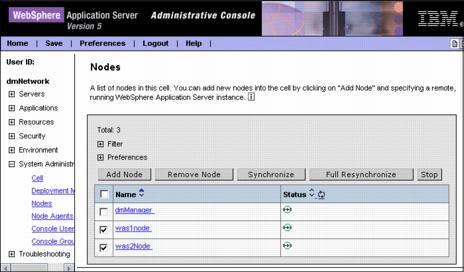Manual regeneration of the plug-in file
Manual regeneration of the plug-in file can be performed at any point, whether appservers are running or not. The result and delay are discussed in 5.4.3, Generation of the plug-in configuration file. There are two methods of manual regeneration:
| From the Administrative Console |
| Via a command line using the GenPluginCfg command |
From the Administrative Console
The Administrative Console can be used to regenerate the plug-in. In a distributed environment, the plug-in will only be regenerated on the Deployment Manager system. This means that all the directory paths of the Deployment Manager will be used, so when pushing the plugin-cfg.xml file to other systems make sure that the paths in the plugin-cfg.xml correspond to the paths of the machine you have copied it to.
To regenerate the plug-in file manually from the Administrative Console:

Figure 5-8 Regenerating the plug-in on the Deployment Manager

Figure 5-9 Full Resynchronization
GenPluginCfg command
The command GenPluginCfg can be used in its simplest form by typing:
GenPluginCfg.sh
Or,
GenPluginCfg.bat (for Windows environments)
This will generate the plug-in configuration file on the node you have run the command on. However, it is recommended that you run this command on the Deployment Manager node and then copy the file to all other nodes to make sure the complete environment's configuration is taken into account. If your Web servers run at the same nodes as your appservers, the command syncNode can be used for copying the plug-in configuration file to the nodes. However, this command can be used only when the Node Agents are stopped.
When generating the plug-in on a node other than the Deployment Manager node, the plug-in will only be regenerated with a subset of the configuration that is local to the node you have run the command from. Therefore generating the plug-in on the Deployment Manager node is the most convenient form of generating the plug-in.
There are many other command-line tools available in WAS V5.1. For details on the GenPluginCfg and syncNode commands as well as other available commands, refer to Appendix A, "Command-line tools", of the redbook IBM WebSphere Version 5.0 System Management and Configuration, SG24-6195.
WebSphere is a trademark of the IBM Corporation in the United States, other countries, or both.
IBM is a trademark of the IBM Corporation in the United States, other countries, or both.